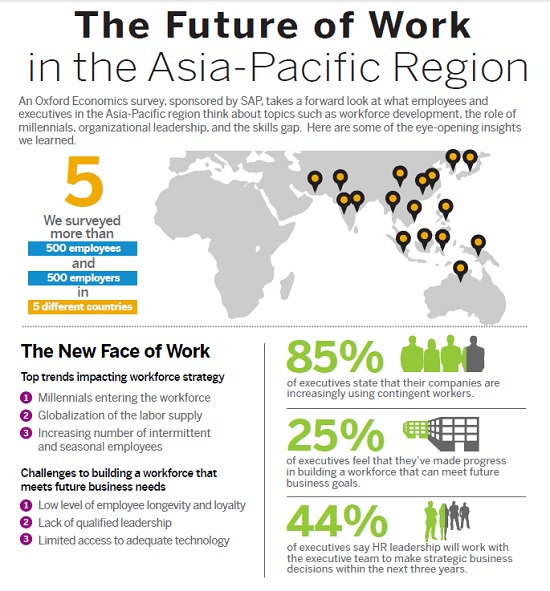APAC firms most affected by millennials in future workforce
By Digital News Asia September 25, 2014
- Frequent training, but lagging in workforce management and tech adoption
- APAC companies fail to fully recognise the talent management changes required

FEAR of obsolescence, along with competitive compensation and benefits, are the key concerns for employees in Asia Pacific, according to a new report by SAP, produced in conjunction with independent research group Oxford Economics.
Companies in the region lead in workforce training and mentoring but lag in talent management and the adoption of new technology in the face of changing needs.
Millennials entering the workforce is identified as the top labour market shift affecting workforce strategy, followed by the globalisation of labour supply, SAP said in a statement.
Workforce 2020 surveyed more than 5,400 executives and employees in 27 countries, including Australia, China, India, Japan and Malaysia.
The study shows that Asia Pacific companies fail to fully recognise the talent management changes that will be required.
Amid growing pressure to find and retain skilled staff, employers in the region undervalue the impact of leadership and soft skills needed to lead a global and diverse workforce; see little merit in loyalty and retention; and fail to appreciate the need for career development opportunities together with work-life balance.
According to the survey, workforce strategy has not been placed in a strategic position across organisations in Asia Pacific to drive business outcomes.
The study’s findings challenge conventional wisdom and highlight the most critical issues facing human resources professionals in the region, SAP said.
Across Asia Pacific, pay and benefits matter most, but career development would increase loyalty, while being laid off is less of a concern than becoming obsolete – even among ‘Millennials.’ Millennials are in fact no more likely to job-hop than non-Millennials.
“As the influx of young, ambitious employees join the workforce across Asia Pacific, it is critical for companies to recognise that their talent management practices and policies will need to evolve,” said Adaire Fox-Martin, president of SAP Asia Pacific Japan.
“Workforce data and analytics will be critical in enabling HR (human resource) managers to track, manage and assess recruitment, demographics, staffing, training, skill sets and incentives in a way that helps the business run better,” she said.
Among the top workforce issues facing companies in Asia Pacific (click infographic to see full version):
 1) Compensation and bonuses matter
1) Compensation and bonuses matter
- For employees in Asia Pacific, defined opportunities for career development is the most important factor to increase loyalty and engagement (46%), followed by more comprehensive benefits (45%) and higher compensation (44%).
- Job satisfaction for Millennials in the region is driven by competitive compensation (67%), but bonuses are more important to non-Millennials (52%).
- 51% of employees are most afraid of their position changing or becoming obsolete, compared with 40% globally, while only 7% cite layoffs as a top concern.
2) Millennials are misunderstood
- While 64% of executives in Asia Pacific say Millennials entering the workforce will have a major impact on their firm’s workforce strategy, only 27% say they are giving special attention to Millennials’ particular wants and needs. Yet, Millennials are more similar to non-millennial coworkers than expected and do not always fit the stereotypes.
- Millennials (21%) are no more likely than non-Millennials (24%) to leave their jobs in the next six months.
- Millennials in Asia Pacific have the same top priorities for job satisfaction as Millennials worldwide, but put significantly more weight on career goals (48% versus 35% globally), income goals (39% versus 32% globally) and advancement (38% versus 29% globally).
3) Leadership and loyalty are undervalued
- Only 27% of executives in the region view long-term loyalty and retention as an important part of their talent strategy, although 82% rely mainly on full-time staff (versus 66% globally).
- Only 11% of executives consider leadership as an important trait in employees, in contrast to 21% globally. Likewise, creativity and problem-solving skills are ranked at only about 5%, half of the weight given to these worldwide.
- Only a quarter of companies in Asia assess employees’ ‘soft’ skills (e.g. leadership, collaboration, creativity, empathy, decision-making ability etc.), compared to 39% elsewhere. Yet, 36% of Asia Pacific executives say their leaders are ready to lead a global workforce, versus 55% in North America.
4) Bridging the talent gap
- More than half of executives in Asia Pacific cite a high level of education or institutional training as the most important employee attribute, much higher than the 33% globally. Addressing this, two-thirds of employees and 70% of executives in the region see their firms offering supplemental training to develop new skills, ahead of the 55% globally.
- But only half of employees say their company provides ample training on the technology they need, and less than one-third say their company makes the latest technology available to them.
- Compared to 53% globally, only 36% of executives in Asia Pacific recognise workforce development as a key differentiator for their firm, even though 43% say that problems with talent and skills affect business performance.
- Only 38% of executives in the region say their company has a culture of continuous learning.
- Although the need for skills, such as analytics, cloud and programming/ development, will grow sizably over the next three years, less than half of employees expect to be proficient in these areas in that timeframe.
5) Compensation models, HR policies and technology
- In Asia Pacific, 44% of executives say changes in compensation plans will be required along with increased investment in training.
- Only 29% say changing nature of employment will result in changes to employee technology policies, such as bring your own device (BYOD), compared to 38% globally. While 31% of employees around the world say their firms currently allow BYOD, it is only 18% in Asia Pacific.
- Executives note an impact, but to a lesser degree, on required investments in HR technology (31% versus 41% globally) and HR policy (20% against 31% globally).
- Only 28% of executives say they have ample data about the workforce to understand their skill strengths and weaknesses, while the same percentage uses quantifiable metrics and benchmarking as part of their workforce development strategy. Only 34% say they know how to extract meaningful insights from the data available to them.
 “Workforce 2020 reveals that employees in Asia Pacific are career-driven, especially Millennials, and what they need is not isolated training, but more leadership and career guidance,” said Fox-Martin (pic).
“Workforce 2020 reveals that employees in Asia Pacific are career-driven, especially Millennials, and what they need is not isolated training, but more leadership and career guidance,” said Fox-Martin (pic).
“Armed with this sort of data and the right tools, companies will be better equipped to invest resources in the right people and programs that will drive retention and help meet business objectives.
“As Millennials shape the future of work, every company must transform itself as an employer in order to compete for talent,” she added.
To learn more about the global results of Workforce 2020 and the future of work, click here.
Related Stories:
Enterprises urged to embrace new work-life paradigm
SEA educators see need for digital media skills in today’s workforce
IBM delivers analytics and workforce science for HR
For more technology news and the latest updates, follow us on Twitter, LinkedIn or Like us on Facebook.

